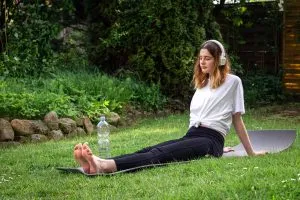Yoga is well known for its unlimited physical and mental health benefits, making it a natural choice for many of us.
It’s a practice that improves our flexibility, balance, and strength while also promoting relaxation and stress reduction.
Very Well Health says about yoga, “It’s good for people with knee pain because it can reduce chronic pain while improving mobility, physical fitness, and overall quality of life”.
For those of us who’ve got knee issues or pain, choosing the appropriate yoga mat thickness can make a huge difference in our level of comfort and safety.
We want to uncover which yoga mat thickness is best suited for many of us who have to deal with bad knees.
Supportive Yoga Mats
Yoga mats aren’t just there to define your space; they are crucial in giving support and cushioning, especially for our joints like knees.
When you’ve got knee pain or sensitivity, choosing for the right mat thickness can help alleviate some of the discomfort you may feel when you’re doing particular yoga poses.
Standard Yoga Mat Thickness
Standard yoga mats are usually around 1/8-inch (3.17mm) thick.
These mats are enough support for many, they might not provide enough cushioning for anyone with bad knees.
If you’ve got knee issues, you might find that poses like lunges, kneeling postures, or poses that put weight on your knees can be quite uncomfortable on a standard mat. While thicker mats dont completely remove that, they can absolutely cuddle your knees while on the mat.
Extra Thick Yoga Mats

With bad knees, an extra thick yoga mat might be the solution. Extra thick mats usually range from 1/4-inch (6.35mm) to 1-inch (25.4mm) in thickness. These mats offer much more cushioning and support than the standard mats do. This makes them an excellent choice for people dealing with knee pain or sensitivity.
The extra thickness can help reduce the pressure on your knees, giving a more comfortable and pain-free yoga session.
Poses that require you to kneel down, like Camel Pose or Hero Pose, become much easier with the added cushioning.
The choice of mat thickness isn’t solely about your knee issues; it’s also about which type of yoga you personally practice. Different yoga styles emphasize different movements and postures, which can impact your comfort level.
Consider Your Yoga Style
- Restorative Yoga: If you mainly practice restorative yoga, where you spend more time in seated or reclined postures, a thicker mat can enhance your comfort. It’s all about creating a cozy, supportive environment for deep relaxation.
- Vinyasa or Power Yoga: For more dynamic practices like Vinyasa or Power Yoga, where you flow through poses and transitions, a slightly thinner mat might be better to cater for your stability and balance.

Balance is Key
While yes, extra thick mats offer excellent cushioning for bad knees, it’s important you strike a balance.
Extra thick mats can reduce stability, making it a bit more of a challenge to keep your balance in standing poses.
So, it’s essential to find a thickness that gives adequate cushioning for your knees without compromising stability in your practice.
Additional Points to Consider
When choosing a yoga mat for bad knees, it’s not just about thickness. Here’s a few other factors to consider:
- Material: Yoga mats are made from lots of different materials, including PVC, rubber, TPE, and natural rubber. Some materials offer better cushioning and durability than others.
- Texture: Mats come with different textures, which can affect your grip during practice. Look for a mat with a non-slip texture to reduce the risk of slipping, especially if you have knee issues.
- Size: Try to make sure that the mat is big enough to accommodate your entire range of motion comfortably.
- Maintenance: Consider how easy the mat is to clean and maintain, hygiene is essential, especially if you have knee problems.
- Price: Quality yoga mats come in various price ranges. Invest in a mat that meets your needs without breaking the bank.
Conclusion
The Arthritis Foundation recommends the use of yoga as an exercise intervention that could be incorporated as a part of a regular OA treatment program, this is particularly for people with bad knees.
In the journey to finding your perfect yoga mat, while thickness does improve the experience with bad knees, it’s also crucial to prioritize your comfort and safety.
Extra thick mats can offer lots of cushioning and support, making your yoga session more enjoyable and hopefully pain-free.
However, it’s essential to strike a balance between cushioning and stability, as overly thick mats may affect your balance in certain poses.
Ultimately, the ideal mat thickness varies from person to person, so perhaps you can try different options and consult with yoga instructors or healthcare professionals for personalized recommendations. Your mat should strengthen your practice and provide the support your knees need to thrive in your yoga journey.
Visit our reviews on Best Thick Yoga Mats for help to decide which yoga mat might suit your knees perfectly!





